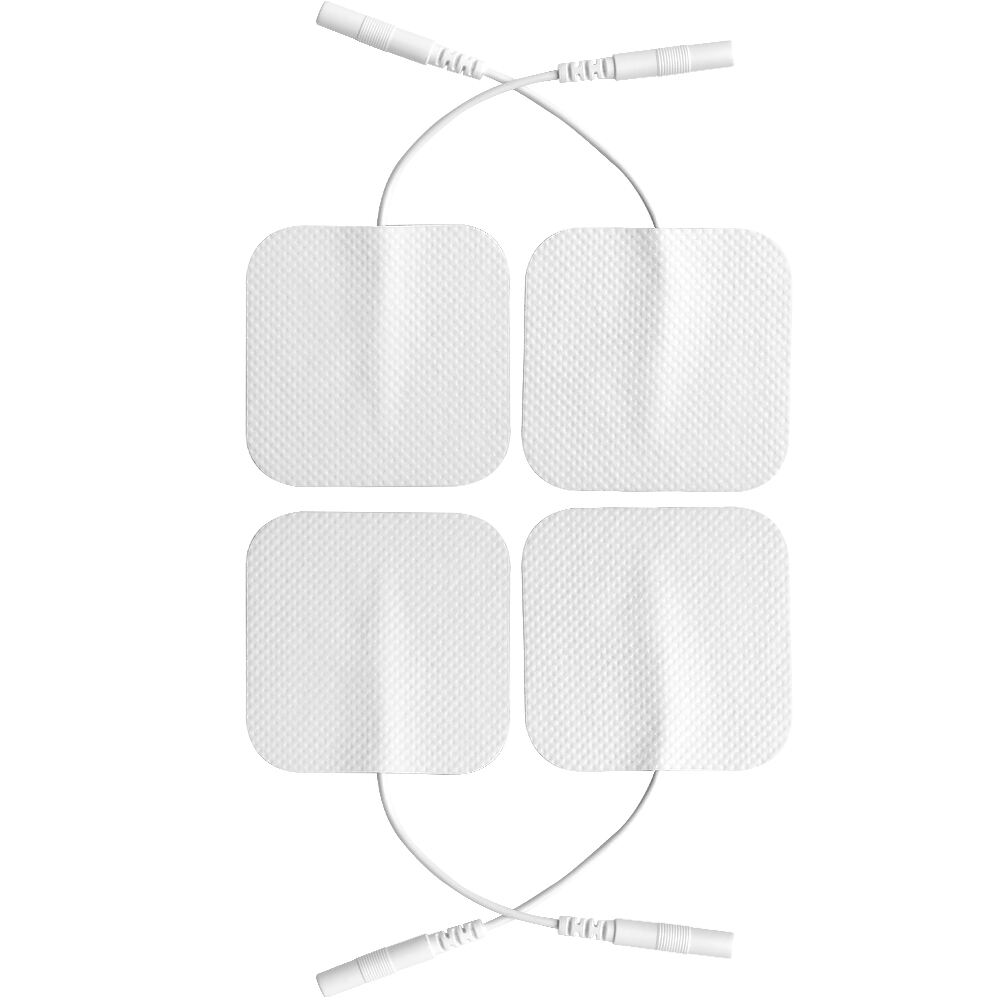What Factors Affect the Effectiveness of Electrode Pads?
Electrode pads are essential components in electrotherapy, used in physical therapy, pain management (e.g., TENS units), muscle stimulation, and rehabilitation. These adhesive pads conduct electrical currents from devices to the body, delivering targeted therapy to muscles or nerves. However, their effectiveness depends on several factors, from material quality to application technique. Understanding these factors ensures electrode pads perform optimally, maximizing therapeutic benefits while minimizing discomfort or inefficiency.
Material Composition of Electrode Pads
The materials used in electrode pads directly impact their conductivity, adhesion, and durability—key to effectiveness.
Conductive Layer Materials
The conductive layer (the part that transmits electrical current) is critical. Most electrode pads use carbon, silver, or stainless steel for this layer. Silver-based electrode pads offer the highest conductivity, making them ideal for low-frequency therapies (e.g., TENS) where precise current delivery matters. Carbon-based pads are more affordable and work well for general use, though their conductivity may degrade faster with repeated use. Stainless steel electrode pads balance durability and conductivity, suitable for high-intensity muscle stimulation but often thicker, which can reduce flexibility.
Adhesive and Gel Quality
The adhesive gel on electrode pads ensures secure contact with the skin and enhances conductivity. Water-based gels are common, providing good conductivity and skin compatibility, but they dry out quickly with repeated use. Hydrogel-based electrode pads retain moisture longer, extending lifespan and maintaining consistent current flow. Silicone-based adhesives offer stronger adhesion, ideal for active patients (e.g., athletes using muscle stimulators), but may cause irritation in those with sensitive skin. Poor-quality gel or adhesive can lead to uneven current distribution, reducing therapy effectiveness and causing "hot spots" (areas of excessive current).
Backing Material
The backing (outer layer) of electrode pads affects flexibility and comfort. Non-woven fabric backings are breathable and flexible, conforming well to curved body parts (e.g., knees, shoulders), ensuring electrode pads stay in place during movement. Plastic or rubber backings are more durable but less flexible, making them better suited for flat areas like the lower back. A rigid backing that doesn’t contour to the body can create gaps between the pad and skin, increasing resistance and reducing current flow—undermining the purpose of the electrode pads.
Skin Preparation and Condition
Electrode pads rely on direct contact with the skin to conduct electricity, so skin condition and preparation significantly impact performance.
Cleanliness and Oil/Grease
Skin naturally produces oils, sweat, and dirt, which act as insulators, blocking current flow from electrode pads. For example, lotion, sunscreen, or body oil on the skin creates a barrier that reduces conductivity, forcing the device to deliver higher currents to achieve the same effect—potentially causing discomfort. Cleaning the skin with mild soap and water (and drying thoroughly) before applying electrode pads removes these barriers, ensuring optimal contact. Alcohol wipes can also be used, but should be avoided on sensitive skin to prevent irritation.

Hair and Exfoliation
Excess hair on the treatment area interferes with electrode pads’ adhesion and conductivity. Hair creates tiny gaps between the pad and skin, increasing resistance and causing current to scatter. Shaving or trimming the area (avoiding nicks, which can increase sensitivity) ensures electrode pads make direct contact. Similarly, dead skin cells buildup reduces conductivity—regular exfoliation (gently, to avoid irritation) helps maintain a smooth surface for better current transmission.
Skin Moisture and Damage
Dry, cracked skin or open wounds hinder electrode pads’ effectiveness. Dry skin has high resistance, while wounds or broken skin can cause uneven current distribution, leading to pain or tissue damage. For patients with dry skin, applying a thin layer of water-based moisturizer (allowed to fully absorb) can improve conductivity without blocking current. Avoid using electrode pads on irritated, sunburned, or infected skin, as this not only reduces effectiveness but also risks worsening the condition.
Size, Shape, and Placement of Electrode Pads
The size and shape of electrode pads, along with their placement, determine how effectively current reaches target tissues.
Size Relative to Treatment Area
Electrode pads that are too small for the target area (e.g., a large muscle group like the quadriceps) may concentrate current in a narrow zone, causing discomfort without stimulating the entire muscle. Conversely, pads that are too large for small areas (e.g., the wrist) can spread current to unintended tissues, diluting the therapy’s impact. Matching electrode pad size to the treatment area ensures current is focused where needed. For example, 2x2-inch pads work well for the neck or hands, while 4x6-inch pads are better for the back or thighs.
Shape and Flexibility
Contoured or pre-shaped electrode pads (e.g., for knees, elbows, or shoulders) conform better to curved surfaces than square or rectangular pads, maintaining contact during movement. Flexible pads (made with stretchable backing) move with the body, preventing peeling or gaps during therapy—critical for active use, such as during physical therapy exercises. Rigid, ill-fitting pads may shift, reducing current delivery to the target area and limiting effectiveness.
Placement and Spacing
Proper placement of electrode pads is key to targeting specific muscles or nerves. For muscle stimulation, pads should be placed on the muscle belly (the thickest part) to maximize contraction. For pain management (e.g., TENS), placing pads around the pain site (not directly on bony areas) ensures current reaches sensory nerves. Spacing between electrode pads also matters: pads that are too close may cause current to "short circuit" between them, while pads that are too far apart reduce current intensity at the target tissue. Following device guidelines for spacing (typically 1–2 inches apart for small areas, 3–4 inches for larger ones) optimizes results.
Usage Frequency, Maintenance, and Lifespan
Electrode pads are designed for limited use, and their effectiveness degrades over time without proper care.
Reuse and Replacement
Most electrode pads are reusable (5–20 times, depending on quality), but each use reduces adhesive strength and gel conductivity. Reusing pads beyond their lifespan leads to poor adhesion, uneven current flow, and reduced therapy effectiveness. Signs that electrode pads need replacement include: loss of stickiness (even after cleaning), dried or cracked gel, or visible discoloration. Using fresh pads ensures consistent performance, though cost-conscious users can extend lifespan by storing pads on their original liner and keeping them away from dust, heat, or direct sunlight.
Cleaning and Storage
Proper maintenance preserves electrode pads’ effectiveness. After use, gently wipe the gel surface with a damp cloth to remove skin oils or debris, then let them air dry before reattaching to their liner. Avoid using soap or alcohol on the gel, as this can break down the conductive material. Storing electrode pads in a cool, dry place (not in direct sunlight or near heat sources like radiators) prevents gel drying. For long-term storage, sealing pads in a plastic bag with a damp paper towel (to maintain moisture) can extend their life, though this is not a substitute for timely replacement.
Device Compatibility
Electrode pads must be compatible with the electrotherapy device to function effectively. Devices deliver specific current types (e.g., TENS, EMS) and intensities, and using pads not rated for the device’s output can lead to inefficient current transfer or even damage. For example, low-quality electrode pads may overheat when used with high-intensity muscle stimulators, reducing effectiveness and risking skin burns. Checking that electrode pads match the device’s specifications (e.g., resistance range, current tolerance) ensures safe, optimal performance.
Environmental Factors
Environmental conditions can affect electrode pads’ conductivity and adhesion, indirectly impacting effectiveness.
Temperature and Humidity
Extreme temperatures degrade electrode pads’ gel and adhesive. High heat (e.g., leaving pads in a hot car) causes gel to melt or dry out, while cold temperatures make the backing rigid, reducing flexibility. Humidity also plays a role: high humidity can weaken adhesion (causing pads to slip), while low humidity accelerates gel drying. Storing and using electrode pads in moderate conditions (60–75°F, 30–50% humidity) preserves their integrity.
Electromagnetic Interference
Though rare, strong electromagnetic fields (e.g., near MRI machines or power lines) can disrupt current flow from electrode pads to the body. This interference scatters the electrical signal, reducing its intensity at the target tissue. While most home or clinical environments don’t have such strong fields, avoiding use near large electrical equipment ensures electrode pads deliver consistent current.
FAQ: Electrode Pads Effectiveness
How can I tell if my electrode pads are still effective?
If the pads no longer stick firmly, cause uneven tingling/burning during use, or require the device to be turned up significantly higher than usual to feel the current, they likely need replacement. Effective electrode pads should deliver a consistent, comfortable sensation across the entire pad surface.
Can I use electrode pads on sensitive skin?
Yes, but choose pads with hypoallergenic adhesives (e.g., latex-free, water-based gels). Test a small area first, and avoid alcohol prep—use mild soap and water instead. If redness or irritation occurs, discontinue use and switch to a gentler pad type.
Does the color of electrode pads affect their performance?
Color is typically cosmetic, but the underlying material matters. Silver-colored pads (with silver conductive layers) often offer better conductivity than black (carbon) pads, though they may cost more. Focus on material specs over color when selecting electrode pads.
How do I choose the right size of electrode pads for my needs?
Match the pad size to the treatment area: small pads (1x1–2x2 inches) for small muscles/joints (fingers, wrists), medium pads (2x4–3x5 inches) for areas like the shoulders or calves, and large pads (4x6 inches or larger) for the back, thighs, or buttocks. Larger areas require larger pads to ensure full coverage.
Can expired electrode pads still be used?
Expired pads may have dried gel or weakened adhesion, reducing effectiveness. While they won’t cause harm, they’re unlikely to deliver optimal current. It’s best to use electrode pads within their expiration date (typically 1–2 years from manufacture) for reliable results.





